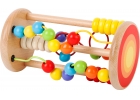Alteraciones perceptivas y práxicas en pacientes con TCE: relevancia en las actividades de la vida diaria. (Parte XIII)
Los déficits perceptivos y práxicos limitan en gran medida la recuperación de este tipo de pacientes e influyen tanto en su pronóstico funcional al alta como durante el proceso de rehabilitación limitando en numerosas ocasiones el éxito de la recuperación física de este tipo de pacientes.
Es fundamental la conciencia sobre las limitaciones de los procesos perceptivos-cognitivos, así como del movimiento por parte del sujeto, ya que determinan en gran medida el éxito de las técnicas de intervención seleccionadas para el tratamiento. De igual relevancia es considerar el grado y análisis de las actividades junto con el potencial del paciente para aprender, ya que variando las características de la tareas y del entorno podríamos aumentar el nivel de independencia funcional del sujeto.
Dadas las características de estos pacientes se hace necesario el reentrenamiento en contextos reales para con ello asegurarnos su correcta intervención y disminuir los problemas derivados de la falta de generalización de aprendizajes.
Las técnicas basadas en los principios de recuperación han mostrado ser menos efectivas que las basadas en la compensación; actualmente se debería tender a utilizar los abordajes dinámicos que utilizan el uso de actividades de la vida diaria con un doble fín: recuperar la función perceptiva y práxica afecta y entrenar al sujeto a lograr el mayor grado de independencia funcional en dicha actividad.
El trabajo terapéutico realizado con las familias de estos pacientes es de vital importancia para el logro de los objetivos establecidos en los programas de rehabilitación.
Referencias
(1) Leon-Carrión,.J. Models of neurobehavioral disorders after brain injury. Brain Injury Sources; 1998.
(2) Del Rosario Dominguez, M. El modelo de rehabilitación CRECER para el daño cerebral adquirido. Minusval. Rehabilitación del daño cerebral. 2002; 2: 62-70.
(3) George Kerkhoff J. Neurovisual rehabilitation:recent developments and future directions. J Neurol Neurosurg Psychiatry 2000; 68:691-706.
(4) Unsworth C. Introduction to cognitive and perceptual dysfunction: Therorial Approaches to therapy. En: Unsworth C, Cognitive and Perceptual Dysfunction. A clinical reasoning Approach to Evaluation and Intevention. Philadelphia: Ed F. A Davis Company;1999. p. 1-40
(5) Carr, J.H y Sheperd, R.B. Neurological Rehabilitation.Optimizing motor performance. Oxford: Butterworth-Heinemann; 2000.
(6) Grieve, J. Neuropsychology for occupational therapists: Assessment of perception and cognition. Oxford: Blackwell Scientific Publications; 1993.
(7) Arnadottir, G. The brain and behavior: Assesing cortical dysfunction through activities of daily living. St. Louis: C. V. Mosby; 1990.
(8) Zoltan B. Vision, perception and cognition. Amanual for the evaluation and treatment of the neurologically impaired adult. En: Zoltan B, Theorical basis for evaluation and treatment. Thorofare: Ed Slack; 1996 p. 1-26.
(9) Gouvier, W.D, y Cubic, B. Behavioral assessment and treatment of acquired visuoperceptual disorders. Neuropsychology Review 1991; 2(1): 3-28.
(10) Hier, D. B, Mondlock, J., y Caplan, L. R. Behavioral abnormalities after right hemisphere stroke. Neurology 1983; 33: 337-344.
(11) Neistadt, M. Occupational therapy for adults with perceptual deficits. American Journal of Occupational Therapy 1988; 42: 434-439.
(12) Neistadt, M. Occupational therapy treatments for constructional deficits. American Journal of Occupational Therapy 1992; 46: 141-148.
(13) Okkema, K. Cognition and perception in the stroke patient: A guide to functional outcomes in occupatinal therapy. Gaithersburg, MD: Aspen Publishers; 1993.
(14) Zoltan, B., Siev, E., y Frieshtat, B. The adult stroke patient: A manual for evaluation and treatment of perceptual and cognitive dysfunction (2nd ed). Thorofare, NJ: Slack; 1986.
(15) Lezak, M.D. Neuropsychological assessment (3er Ed). New York: Oxford University Press; 1995.
(16) Cohen AH, Rein LD. The effect of head trauma on the visual system: The doctor of optometry as a member of the rehabilitation team. J Amer Optometric Association. 1992; 63(8): 530-536.
(17) Luria, A. R. Higher cortical functions in man. New York: Basic Books; 1966.
(18) Levine, D. N., Warach, J., y Farah, M. Two visual systems in mental imagery: Dissociation of “ what” and “where” in imagery disorders due to bilateral posterior cerebral lesions. Neurology 1985; 35:1010-1018.
(19) Mishkin, M., Ungerleider,L., y Macko, K. Object vision and spatial vision: Two cortical pathways. Trends in Neuroscience 1983; 6:414-417.
(20) Post R. B., y Liebowitz, H.W. Two modes of processing visual information: implications for assessing visual impairment. American Journal of Optometry and Physiological Optics 1986; 63:94-96.
(21) Giles, G. M.,y Clark-Wilson, J. Brain Injury rehabilitation: A neurofunctional approach. San Diego, CA: Singular Publishing Group; 1993.
(22) Gil R. Apraxias. En Gil R, eds. Neuropsicología. Barcelona: Ed. Masson; 1999. P.75-90.
(23) Hanna-Pladdy B & González Rothi LJ. Ideational apraxia: Confusion that began with Liepmann. Neuropsychological Rehabilitation, 2001; 11 (5): 539 – 547.
(24) Grieve J. Neuropsicología para Terapeutas Ocupacionales. Evaluación de la Percepción y Cognición. Madrid: Ed. Médica Panamericana; 2000.
(25) Roy EA & Square PA. Common considerations in the study of limb, verbal and oral apraxia. En EA Roy (Ed.), Neuropsychological studies of apraxia and related disorders (pp. 111 – 161). Amsterdam: North Holland; 1985. P.111 – 161.
(26) Rothi LJG, Ochipa C & Heilman KM. A cognitive neuropsychological model of limb praxis. Cognitive Neuropsychology 1991; 8, 443 – 458.
(27) García Peña M & Muñoz Céspedes JM. Apraxias e independencia funcional en personas con daño cerebral adquirido. Polibea 2000; 57, 34 – 39.
(28) Chaikin E. L,. Disorders of vision and visual-perceptual dysfunction. En : Umphred, D. A. Neurological Rehabilitation. St Louis: C. V. Mosby; 2001.
(29) McCarthy RA & Warrington EK . Cognitive neuropsychology: A clinical introduction. San Diego: Academic Press; 1990.
(30) Tate RL & McDonald S. What is Apraxia? The Clinician’s Dilemma. Neuropsycholological Rehabilitation 1995; 5 (4), 273 – 297.
(31) Jackson T. Dyspraxia: Guidelines for Intervention. British Journal of Occupational Therapy 1999; 62 (7), 321-26.
(32) Poeck K . The clinical examination of apraxia. Neuropsychologia 1986; 24 (1), 129-34.
(33) Ochipa CR, Rothi LJG & Heilman SM. Conceptual apraxia in Alzheimer’s disease. Brain 1992; 115, 1061 –1071.
(34) Benton, A. L., Sivan, A. B., Hamsher, K.,Varney, N. R., y Spreen O. Contributions to neuropsychological assessment (2nd ed.). New York: Oxford University Press; 1994.
(35) Neistadt, M. Perceptual retraining for adults with diffuse brain injury. American Journal of Occupational Therapy 1994b; 48(3):225-233.
(36) Neistadt, M. Using research literature to develop a perceptual retraining treatment program. American Journal of Occupational therapy 1994 a; 48(1):62-72.
(37) Warren, M. A hierarchical model for evaluation and treatment of visual perceptual dysfunction in adult acquired brain injury, Part I. American Journal of Occupational therapy 1993; 47(1):42-53.
(38) Warren, M. A hierarchical model for evaluation and treatment of visual perceptual dysfunction in adult acquired brain injury, Part II. American Journal of Occupational therapy 1993; 47(1):55-66.
(39) Warren, M. Visual spatial skill. American Occupational Therapy Association Self Study Series on Cognitive Rehabilitation. Rockville, MD: American Occupational Therapy Association; 1994.
(40) Neistadt, M. Relation of perceptual and body image dysfunction to activities of daily living of persons after stroke. American Journal of Occupational Therapy 1995; 49(6): 551-559.
(41) Toglia, J. P. Approaches to cognitive assessment of the brain injured adult: Traditional methods and dynamic investigation. Occupational Therapy Practice 1989; 1(1): 36-57.
(42) Toglia, J. P. Generalization of treatment: A multicontext approach to cognitive perceptual impairment in adults with brain injury. American Journal of Occupational Therapy 1991; 45: 505-516.
(43) Toglia, J. P. Unilateral visual inattention: Multidimensional components. Occupational Therapy Practice 1991; 3:18-34.
(44) Toglia, J. P. A dynamic interactional approach to cognitive rehabilitation. En Katz, N. Cognitive rehabilitation: Models for intervention in occupational therapy. Andover, MA: Andover Medical Publishers; 1992.
(45) Benton A. L., y Tranel, D. Visuoperceptual, visuospatial and visuoconstructive disorders. En Heilman K. M., y Valenstein E. Clinical Neuropsychology (3er Ed). New York: Oxford University Press; 1993. p.165-213.
(46) Efferson, L. Disorders of vision and visual perceptual dysfunction. En Umphred D., Neurological Rehabilitation (3ed Ed). St. Louis: C.V. Mosby; 1995.p.769-801.
(47) Hooper, H. E. Hooper Visual Organization Test. Los Angeles, CA: Western Psychologycal Services; 1983.
(48) Benton , A. L., Varney, N. R. y Hamsler, K. Visuospatial judgement: A clinical test. Archives of Neurology 1978; 35:364-367.
(49) Warrington, E., y James, M. Visual Object and Space Perception Test. Suffolk, England: Thames Valley Test Co; 1991.
(50) Colarusso, R. P., y Hammill, D.D. MVPT. Motor FreeVisual Perception Test. Novato, CA: Academic Therapy Publications; 1972.
(51) Bouska, M. J.,y Kwatny, E. Manual for application of the Motor Free Visual Perception Test to The adult Population. Philadelphia: Temple University Rehabilitation Research and Training Center No 8; 1983.
(52) Gardner, M. F. Test of Visual-Perceptual Skills (Non-motor) Manual. Burlingame,CA: Psychological and Educational Publications; 1982.
(53) Henderson, A. A functional typology of spatial abilities and disabilities: Part I. Sensory Integration Quarterly 1992-93a; 20(3):1-5.
(54) Henderson, A. A functional typology of spatial abilities and disabilities: Part I. Sensory Integration Quarterly 1992-93b; 20(4):1-5.
(55) Itzkovich M., Arerback S., Belazar. Lowenstein Occupatinal Therapy Cognitive Assessment. Maddack Inc. Pequanock, NJ; 1990.
(56) Kanehara et al. Ishihara Color Plates. Tokio: Berneil Group; 1977.
(57) Macdonald J. An investigation of body scheme in adults with cerebral vascular accident. American Journal of Occupational Therapy 1981; 14: 72-74.
(58) Bea Muñoz M y Medina Sánchez. Dificultades perceptivas y cognitivas en personas con ictus cerebral: detección y estrategias de compensación y superación. Rehabilitación (Madr) 2000;34 (6): 468-482.
(59) Cermak, S y Lin K. Assessment of unilateral neglect in individuals with right cerebral vascular accident. Topics in Geriatric Rehabilitation 1994; 10:42-55.
(60) Sánchez Cabeza, A y García Peña, M. Reflexiones sobre el proceso de tratamiento de las disfunciones cognitivas y perceptivas. Revista informativa de la Asociación Profesional Española de Terapeutas Ocupacionales 2002; 28: 2-13.
(61) De Renzi et al. Modality specific and supramodal mechanisms of apraxia. Brain 1982; 105, 301-312.
(62) De Renzi E & Luchelli F. Ideational apraxia. Brain 1988; 111, 1173 – 1185.
(63) Alexander et al . Neuropsychological and neuroanatomical dimensions of ideomotor apraxia. Brain 1992; 115, 87-107.
(64) Rothi LJG & Heilman KM. Acquisition and retention of gesture in apraxic patients. Brain and Language 1984; 3, 426-432.
(65) Laver A. J., y Powell, G. E. The Structured Observational Test of Function (SOTOF). Windsor: NFER-NELSON; 1995.
(66) Abreu B et al. Occupational performance and the functional approach. En Royeen CB. AOTA self–study series: cognitive rehabilitation, Rockville, Md, American Occupational Therapy Association; 1994.
(67) Edmans J. A.,y Lincoln N. B. Treatment of visual perceptual deficits after stroke. Int Disabil Studies 1989; 11:25.
(68) Trombly C. Clinical practice guidelines for post-stroke rehabilitation and occupational therapy practice. American Journal of Occupational Therapy 1995; 49:711-715.
(69) Neistadt M. The neurobiology of learning: implications for treatment of adults with brain injury. The American Journal of Occupational Therapy 1994; 48:421-429.
(70) Bruce M.Cognitive rehabilitation: intelligence, insight and knowledge. En Royeen CB.Ed: AOTA self-study series:cognitive rehabilitation. Rockville MD. American Occupational Therapy Association; 1994.
(71) Giles GM y Clarck-Wilson J. The use of behavioral techniques in functional skills training after severe brain injury. The American Journal of Occupational Therapy 1988; 42: 658-661.
(72) Katzmann S y Mix C. Improving functional independence in a patient with encephalitis through behavioral modifications shaping techniques. The American Journal of Occupational Therapy 1994; 48:259-265.
(73) Zemke R. Task, skills, problem solving and social interaction. En Royeen CB.Ed: AOTA self-study series: cognitive rehabilitation. Rockville,Md. American Occupational Therapy Association; 1994.
(74) Gillen G & Burkhardt A. Stroke Rehabilitation. A Function-Based Approach. New York: Mosby; 1998.
(75) Rubio K.B., y Van Deusen J. Relation of perceptual and body image dysfunction to activities of daily living of persons after stroke. The American Journal of Occupational Therapy 1995; 49(6):551-559.
(76) Rosembloom A., y Morgan M. Principles and Practice of pediatric optometry. San Francisco, JB. Lippincott; 1990.
(77) Lin K. C. Right-hemispheric activation approaches to neglect rehabilitation poststroke. The American Journal of Occupational Therapy 1996; 50:504-15.
(78) Manly T. Cognitive rehabilitation for unilateral neglect: Review. Neuropsychological Rehabilitation 2002 12 (4), 289-310.
(79) Ayres A. Developmental dyspraxia and adult-onset apraxia. Torrance, USA: Sensory Integration International; 1985.
(80) Butler J. Rehabilitation in Severe Ideomotor Apraxia using Sensory Stimulation Strategies: A Single-Case Experimental Design Study. British Journal of Occupational Therapy 2000; 63 (7), 319-328.
(81) Goldenberg G & Hagmann S. Therapy of Activities of Daily Living in Patients with Apraxia. Neuropsychological Rehabilitation 1998; 8 (2), 123-141.
(82) Goldenberg G, Daumuller M, Hagmann S. Assessment and therapy of complex activities of daily living in apraxia. Neuropsychological Rehabilitation 2001; 11 (2), 147-169.
(83) Foundas AL et al. Ecological implications of limb apraxia: evidence from mealtime behaviour. Journal of the International Neuropsychological Society, 1995; 1, 62-66.
(84) Sundet K, Finset AY & Reinvang I. Neuropsychological predictors in stroke rehabilitation. Journal of Clinical and Experimental Neuropsychology, 10, 363-379.
G R A T I S
-
Juego de niños es un canto de amor a la creatividad, al cambio y, en definitiva, a los niños que han tenido que dejar su país en b...14.90 €
-
Las manos juegan - los oídos perciben - los ojos admiran. Las bolas de madera multicolor ruedan a través de los tres bucles de mot...15.10 €
-
De un día para otro todo ha cambiado en la vida de Sofía. Su novio, el hijo del jefe del restaurante donde trabajaba, se ha marcha...18.00 €
-
Esta obra ofrece al terapeuta un texto donde se integran tres sistemas florales —Flores de Bach, Orquídeas del Amazonas, y una sel...10.99 €
ARTÍCULOS RELACIONADOS
- Estudiar, aprender, razonar y... entender. (Parte II)
- Estudiar, aprender, razonar y... entender. (Parte VII)
- Estudiar, aprender, razonar y... entender. (Parte VI)
- Ejemplos prácticos. Estudiar, aprender, razonar y... entender. (Parte V)
- Estudiar, aprender, razonar y... entender. (Parte IV)
- La inserción en la escuela de alumnos pre-adolescentes y adolescentes con dificultades en la convivencia. Rol del Equipo Directivo. (Parte I)
- Apuntes sobre el uso de las tecnologías de la información y las comunicaciones para el aprendizaje (Parte IV)
- Apuntes sobre el uso de las tecnologías de la información y las comunicaciones para el aprendizaje (Parte III)
- Apuntes sobre el uso de las tecnologías de la información y las comunicaciones para el aprendizaje (Parte III)











